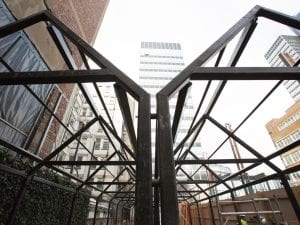At the Royal Central School for Speech and Drama, the Design for the Stage course offers learning through collaboration with those studying on Central’s design, production and acting courses, gaining a deep insight into other practices. Jasper Hardcastle discusses the opportunities presented by the course and plans for the future.
A: What is the nature of this course, and how does it prepare students for realised productions and performance contexts?
CSSD: The Design for Stage course is a specialised, three year course for those interested in developing skills in both costume and set design. Through a range of workshops and skills sessions students learn how to navigate the design process of a full scale show whilst constantly developing their own creativity and design skills. Primarily, training is manifested throughout the course in realised projects and productions within Central as well as professional placement opportunities, recent placements have occurred at The Royal Opera House, The National Theatre and Punchdrunk.
A: Who will be teaching on the course in 2018?
CSSD: The course leader for Design for Stage is Aldona Cunningham who has been teaching in Central’s specialised Design Studio for the last 10 years. Being a designer herself she has helped develop shows for the; Scottish Opera, Leicester Haymarket, English Touring Opera and The Young Vic. Furthermore students often receive lectures and workshops from other related tutors at Central as well as a whole array of visiting lecturers whom are currently working in the industry giving you access and insight into the current industry beyond the walls of Central.
A: What is the relevance of both theory and practical knowledge in this course, and how do the two engage together?
CSSD: The course combines theory based workshops with realised projects where students plans are converted into three dimensional structures and clothing throughout all three years of the course. Projects are then reflected upon post production through write ups which are designed for students to identify the quality of the project and their designs. In turn this ensures that future projects students work on are able to develop from previous work. In essence both theory and practical work go hand in hand and influence one another. Throughout the three years projects and workshops alike become more advanced as students’ knowledge base grows and develops.
A: Why do you think the course is particularly relevant to those looking to work with both creativity and professionalism?
CSSD: There is a brilliant merge between the creative aspect of conjuring ideas and putting them onto the page (either with pen and paper or through Computer-Aided Design programs such as AutoCAD) and the professional side of public shows and projects. Students who work on these public projects work in such a way that it mirrors the role of a designer in the professional industry thus making the transition from student to professional almost seamless. There are also a number of opportunities on the course to promote your work to the industry including the Design and Crafts exhibition.
A: What have some of your previous graduates go on to do?
CSSD: Recent graduates have gone on to work as Designers, Art Department Assistants and Production Designers in theatres such as The National, The Hampstead, Southwark Playhouse to name a few. Graduates have also worked on feature films such as Muppets Most Wanted.
A: What are you most looking forward to about the students who will be on the next course?
CSSD: Personally I am looking forward to what ideas are going to be brought to the table from the next crop of students. Every year students bring fresh ideas to the table from their previous training and work from across the country and world. This, mixed with the opportunity to experiment and focus learning means that realised productions develop to an aesthetically stunning piece of theatre enhancing the overall performance.
Find out more: www.cssd.ac.uk
Credits:
1. Courtesy of CSSD.





